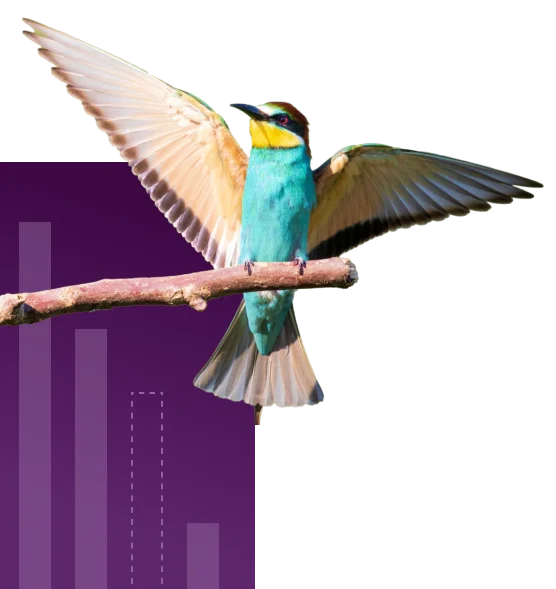How to Develop Cloud Application? A Step-by-Step Guide
Table of Contents
The business world is a Formula 1 race, and clunky software is like a three-wheeled car. You might have the drive to win, but outdated applications can leave you in the dust. Old, traditional setups are getting out of the race and native cloud application development is taking center stage.
A study by McKinsey & Company found that cloud-based businesses are 23% more agile than traditional businesses, making them reliable sources for adapting to new market conditions and scaling resources.
In this blog, we’ll explore the world of what are cloud based applications and how it can be developed step by step, why it’s the key to staying ahead of the competition, and how it can become the engine that drives your business forward.
What is a Cloud-based Applications?
A cloud-based application, also popular by the name online or web-based application, is a software program that lives on the internet rather than on your computer. Imagine a remote server acting as a giant supercomputer, storing and running the app. Users can access it through a web browser, which is similar to visiting a website. This means you can utilize the app from any device with an internet connection, anytime, anywhere.
Let’s take an example. Google Docs is a cloud-based application; you can access it through a web browser and download it to your phone as well. This app allows you to access, view or edit documents from any device and even collaborate with others in real-time.
Features of Cloud-based Applications


Here’s what defines cloud-based applications in terms of features:
- Accessibility: You can access cloud apps from any internet-connected device, like desktops, tablets, or smartphones, without worrying about your specific browser capabilities.
- Offline Access: Some cloud apps also allow you to access and store data temporarily without internet connectivity. When you reconnect, the app syncs automatically.
- Scalability: Cloud storage allows for easier scaling of data and resources to meet your business needs.
- Customization: Cloud-based applications often offer more incredible customization options compared to web apps.
- Security: Users can manage backup schedules, data encryption, and compression for added security.
- Integration: Cloud apps can integrate with external services through APIs, expanding their functionality.
Now that we have discussed what features define a good cloud application, we can go ahead with the main focus of the blog, i.e. Cloud Application Development.
What is Cloud Application Development?
Cloud application development is like building software specifically designed to run on the internet (“cloud”). It involves different stages, similar to traditional software development, that prepare the app to launch and function smoothly. While various tools and approaches exist, companies often choose specific technologies to fit their needs. These cloud-based applications rely heavily on the internet for functionality.
Beyond the app itself, cloud application development opens doors for web and progressive web application (PWA) development services. This can lead to:
- Lower development costs
- Collaboration with remote teams
- Faster project completion times
These benefits are often achieved through Agile development methodologies, which emphasize flexibility and adaptation.
Finally, this goes hand-in-hand with cloud inventory management. This helps businesses track and manage the resources their cloud apps use, leading to optimal use of resources, cost control, and efficient provisioning for future projects.
Challenges in Developing Applications for the Cloud

Even though cloud app development brings a whole new horizon, it’s not without its bumps in the road. Here are some common challenges businesses face, along with tips to navigate them smoothly:
1. Reliability
Cloud-based application development offers a world of opportunities, but when it comes to reliability, you might feel you need to be in a tough spot at times. Unlike on-premise solutions, where you control the hardware, cloud apps rely on your provider’s infrastructure. Gartner’s research found that 68% of IT leaders reported experiencing at least one cloud outage in the past year. These can directly impact your application’s availability and user experience.
To avoid this setback, find a reliable cloud app development provider who commits to a strong uptime record. They will allow you to design a dynamic application that is compact and can address any potential issues. By continuously monitoring performance and implementing robust security practices like encryption and access controls, you can build a self-healing and secure cloud application that delivers a seamless user experience.
2. Portability and Interoperability
While scaling up and down is easy with cloud resources, managing them effectively requires careful planning and oversight. Research from Flexera showed that 30% of cloud spending goes to waste due to unused or underutilized resources.
While you leverage the specific cloud platform as recommended by your cloud partner, it is crucial to consider the functioning of the app around multiple cloud environments. Taking care of this factor empowers you to avoid vendor lock-in and promises uninterrupted access to your customers.
To overcome these challenges, learning about cloud computing and its best practices is important. Moreover, careful upfront planning is the first thing you must do. Adopting industry standards and best practices, are vital strategies for achieving true interoperability and portability in your cloud application.
3. Data Privacy & Security
Building trust with your users starts with prioritizing data privacy and security. A recent KPMG report found a whopping 86% of users consider data privacy a primary concern. While cloud providers offer strong infrastructure security, securing the user experience (client-side) is your responsibility, too.
Fortify your cloud app with a layered defence. Understand your cloud provider’s security measures, then add extra security protocols directly to your application. Prioritize data encryption and established cloud security practices. Choosing the right and top SSL certificate is crucial to protecting sensitive information and ensuring secure connections. These steps build trust and enhance your application’s overall security posture.
4. Performance Issues
A one-second delay in page loading time can impact your conversion rate by 5% (like signups or purchases), indicating significant revenue loss, especially for eCommerce businesses. (another finding from Dynatrace study, 2023).
They are technically alarming you if you are planning to develop a cloud-based app. These apps might promise agility, but making their performance outshine is always a challenge. Unexpected traffic spikes can overwhelm resources, leading to crashes or slowdowns, like a significant airline outage that caused booking delays (2022). Additionally, reliance on internet connectivity means network issues can render your app inaccessible.
To mitigate these risks, perform rigorous performance testing before launch. You can utilize auto-scaling to handle fluctuations in user traffic. Another way out is by leveraging Content Delivery Networks (CDNs) to deliver content closer to users and improve loading times. By proactively addressing performance, you can ensure a smooth user experience that keeps customers happy and your revenue flowing.
Furthermore, seeking guidance from expert cloud computing consulting services provider can provide valuable insights into optimizing performance and addressing potential challenges.
5. Integration challenge
Connecting your cloud app to other systems can feel like a tug-of-war. Legacy systems with outdated technology often clash with building modern cloud applications, as stated by CloudBees research, 2024. Additionally, complex APIs act as bridges between systems, but managing different versions and protocols can be a headache. Security is another concern, as breaches can occur through vulnerabilities in third-party integrations (Verizon, 2023).
To bridge this gap, choose cloud services with strong integration standards. Implement robust error handling and monitoring to identify potential issues. Consider using middleware, integration platforms, or even developing custom APIs to simplify the connection process. By focusing on seamless integration, you can create a collaborative environment that unleashes the full potential of your cloud application.
How to Develop Cloud-Based Application Step-by-Step?


Majorly there are two types of cloud development takes place:
- Web Development: Web development includes creating and maintaining websites and web applications accessed with internet connections. Its process encompasses front-end, back-end, and full-stack development.
- Mobile Solutions: The mobile development process covers creating applications for mobile devices like smartphones and tablets. It includes native mobile app development, cross-platform development, and web-based mobile app development.
Before you decide to get into the development process, conduct in-depth market research and get answers to the following questions:
- What kind of application your target audience needs?
- What functionalities are must-haves in your application?
- How do you give your application a user-friendly interface?
- What technicalities must be taken care of while developing the application?
Once you have the answers, you can go ahead with the following cloud app development process:
Step 1: Project Discovery and Outline Objectives
It is crucial to outline the app development objectives and align all the key stakeholders. This all must be done in the project discovery phase itself, so whenever you are connecting with the development team, you have set precise requirements around the following:
- Vision, goals, and expected results from the app.
- Application Architecture
- Automated workflows
- Data storage and accessibility
- Inter and intra-team connectivity
- Project Complexity and related costs.
- Reporting and analytics capabilities.
- Data integration capabilities across various systems.
Deciding on all these factors helps in creating a well-architected minimum viable product.
Step 2: Build Your Development Team
Here comes the most crucial part: building an app development team that can take care of the process and deliver you the final product, ready to launch in the market.
Now, you have the following choices:
Freelance App Developer: Works individually and might not have overall expertise in building a cloud app and optimizing it for peak performance. They have a flexible work style, which later brings inconsistency in the work.
In-house team: This would be a one-time investment that can cultivate long-term results. Investing in building an in-house can be expensive and time-consuming and does not promise expected results.
Outsourcing: Comes with a team of experts, including solution architects, developers, business analysts, quality assurance engineers, and more. They are cost-effective, can work in your time zone, and deliver expected applications set for the market.
Now, there are a couple of things that you must keep in mind while selecting a app development company:
- Previously delivered projects
- Technologies and platforms on which their expertise is in.
- Security protocols and adherence to compliances
- Customer reviews
- Industries to which they serve.
- Post-launch support and training, etc.
Step 3: Identifying Key Features for Your Cloud Application
Plan an app that your users can easily resonate with. For this, you must build essential features to enhance the overall experience. Here are some critical aspects to consider:
Device Compatibility: Make sure your app is compatible across different devices and operating systems, allowing you to tap into more customers and engage users with your app seamlessly, whenever and wherever they want.
Secure Application Environment: Users tend to trust more on applications backed with solid security protocols like user authentication and role-based access control than loose ends. Incorporate security measures to safeguard your sensitive data and ensure that only authorized personnel can access specific functionalities within the application.
Collaborative Tools: Do not miss out on integrating real-time collaboration tools for live editing of documents, records, and files, instant messaging, and shared workspaces. These tools strengthen team coordination and boost productivity by allowing multiple users to work on projects simultaneously.
Alerts and Notifications: Develop a notification system informing users about essential notifications, updates, deadlines, or changes. These regular alerts help with user engagement and ensure critical information does not go missing.
Scalability: Make sure that your application is scalable enough to the flexible user demand. As your users grow, your application can handle the increased workloads without compromising performance.
Step 4: Structuring the Cloud Application Architecture
The core elements of cloud app architecture are performance and scalability. Here are four models to consider from:
Monolithic Architecture: Through this architecture, you can build a single and unified unit. Although it simplifies the initial development, it can later restrict scaling and updating components independently, making it less flexible for future enhancements.
Microservices Architecture: This model breaks the application into more minor, independent services communicated using APIs. This architecture has a high scalability scope and allows teams to deploy updates to individual services without affecting the entire application. However, this complexity can introduce challenges in managing inter-service communication and performance.
Serverless Architecture: Another model we have is serverless, i.e., Function as a Service, which allows developers to build applications using event-driven functions that execute in response to specific triggers. This cost-effective architecture simplifies resource management, though it may not be suitable for applications requiring extensive processing power.
According to O’Reilly, by 2020, 40% of organizations had fully embraced serverless architecture. Since then, serverless computing has emerged as a leading environment for application execution. The State of Cloud Native Security Report 2023 indicates promising growth ahead, with 70% of survey participants expressing intentions to increase their use of serverless technologies within the next two years. Source
Hybrid Architecture
It combines on-premises infrastructure with public and private cloud resources; hybrid architecture offers flexibility and can optimize resource allocation. However, there are still chances that it presents integration challenges and needs careful management to ensure security across environments.
Step 5: Finding the Right Technology Stack
When you have the right cloud advisors aside, you can leave the selection of the appropriate technology stack for the development process. Here are factors to consider:
- Project Requirements: Determine the technical needs of your project, like scalability, integration capabilities, and security requirements.
- Development Speed: For rapid development, you can ask your development partner to use frameworks like Django (Python) for scalable applications or Ruby on Rails for projects that require quick prototyping and testing.
- Team Expertise: Make sure that people’s skills align well with the project’s requirements.
- Cost Considerations: Evaluate the costs of different technologies, including licensing fees, hosting expenses, and ongoing maintenance. This helps in saving a lot.
It’s not mandatory that what worked out for your competitor will outshine you. Select a technology stack that is capable of fulfilling your unique needs.
Step 6: Designing the User Interface for Your Cloud Application
An application’s UI (User Interface) determines how your users will connect with your application. Align the UI of your application with the target audience, and here are some pointers to remember:
- Embrace Responsive Design
Your cloud application must provide a consistent user experience across devices and operating systems. You can implement responsive design to seamlessly adjust to various screen sizes, facilitating an effective interaction on smartphones, tablets, and desktops.
- Ensure Intuitive Navigation
Easy navigation plays a significant role in user satisfaction. Ask the architect to design your application to allow users to explore its features effortlessly and navigation patterns to reduce the learning curve, allowing users to engage without confusion.
- Incorporate Dark Mode Options
Many users prefer dark mode for better visibility and reduced eye strain. Keep the element in your application’s UI to support this feature, giving users an edge to modify system settings for a comfortable viewing experience.
Step 7: Develop and Test Your Cloud Application
The development of cloud applications follows Agile or DevOps methodologies, varying from the preference of team and project. Here is how both methods work:
Agile Development
Agile methodology is mostly about iterative and incremental progress. Under this, development is organized into short cycles or sprints, typically lasting two to four weeks. This method prioritizes delivering maximum business value and a potentially shippable product increment at the end of each sprint.
Key Points:
- Agile promotes continuous collaboration and communication, so ensure your team has the tools to facilitate this.
- Flexibility is the fundamental element of Agile methodology, making it essential for stakeholders to provide regular feedback throughout the development process.
DevOps Methodology
DevOps aims to integrate development and operations teams, maximizing collaboration throughout the application lifecycle. This approach emphasizes continuous integration and delivery (CI/CD) and automation.
Key Points:
- Transitioning to a DevOps culture might ask for organizational changes. Teams should adopt a collaborative mindset and shared responsibilities.
- Implementing various tools for CI/CD and testing can lead to integration challenges, so selecting compatible tools and establishing transparent processes for their use is essential.
Step 8: Deployment and Ongoing Maintenance
Once your cloud application is developed, it’s time to proceed with deployment and ongoing maintenance. With the ever-growing technical dynamics, regular maintenance is essential to keep your application relevant and functional. Here are some things to focus on:
- Security Enhancements: Keep your app updated with updates and patches to protect user data from emerging threats.
- Performance Tuning: Monitor and optimize the application’s responsiveness and scalability to meet evolving user demands.
- Adaptability: Adjust the application’s capabilities to address fluctuations in user traffic and the introduction of new features.
- Technology Upgrades: Stay updated with advancements in your technology stack, frameworks, and libraries to ensure optimal performance and security.
Advantages of Building Applications for the Cloud


No problem! The cloud lets you seamlessly scale up resources to handle the unexpected rush, eliminating the need for expensive heavy investments in hardware. You’ll always be prepared, no matter how big you get. This flexibility is why Gartner predicts that by 2025, a rise in 70% of business’s IT infrastructures will be cloud-based. It’s clear that scalable solutions are the future, and the cloud is here to help you get there.
Reducing Your IT Bill:
Are you still paying high maintenance costs for on-premise infrastructure and IT staff? It’s time for you to revise your decision regarding cloud solutions. Today, you only pay for the resources you utilize, which saves you millions. Flexera report revealed that companies can achieve a 20-30% cut-down in IT infrastructure costs by embracing the cloud. That’s the real money you can reinvest back into your business!
Fast Time to Market:
Cloud platforms come with pre-installed infrastructure and services, eliminating tedious setup and management processes. This allows your team to focus solely on developing your application and get it into the hands of your customers faster. A latest McKinsey & Company study found that cloud adoption can reduce application deployment times by up to 50%, giving you a significant advantage over competitors.
Uptight Security for Your Data:
Cloud providers offer robust security features and constantly monitor and update their infrastructure. It keeps your data protected from cyberattacks and unauthorized access and allows you to work without any breakout. A recent study by the Cloud Security Alliance (2024) found that 94% of companies believe that cloud security is as good or even better than traditional on-premise solutions.
Examples of Successful Applications Built for the Cloud and Their Impact


Cloud applications have become the backbone of modern business, offering a suite of powerful tools and services that simplify operations and drive success. Here’s a glimpse into some of the critical benefits cloud applications bring:
Software-As-A-Services: Salesforce:
Salesforce is the leading SaaS (Software-as-a-Service) platform that helps businesses manage customer relationships and identify potential sales leads. It uses generative AI to analyze customer data, allowing your sales team to close deals faster. This cloud-based platform also offers separate tools for customer service and marketing, keeping everything organized in one place.
Infrastructure-As-A-Service – IBM Cloud:
This kind of building is more like building a digital infrastructure, even in the absence of any giant physical servers or heavy cables. IBM Cloud offers a strong foundation for your cloud applications. Its “bare metal” services act like a pre-built structure which you can set up easily and quickly for big projects. It also offers some excellent virtual servers, which are like building blocks but flexible, perfectly suitable for projects demanding more adaptability and scope for growth.
Platform-As-A-Service: Heroku:
Another one on the list we have is Heroku. It is a PaaS platform which developers use to deploy, manage, and scale their cloud applications without any hassle.
It supports various programming languages like Ruby, Java, and Python, equipping developers with the flexibility to code in their preferred language and potentially expediting development.
File Sharing & Data Storage: Google Drive:
Let’s say we all want a secure and central hub for all your business files. Google Drive is a cloud-based storage solution that empowers teams from anywhere to connect, access, view and share documents and files. You can integrate it seamlessly with other Google tools and even Microsoft Office files. As your projects grow, you can use the search functionality to find specific files. Most importantly, Google Drive encrypts your data and eradicates any potential security threats, allowing you to work at your pace with complete peace of mind.
By leveraging these transformative cloud services, your business can become more flexible, efficient, and profitable. Imagine the possibilities!


Final Words
Cloud applications can introduce you to a trove of benefits and revenue-generating possibilities. But to reap this kind of reward amongst endless complexities can feel overwhelming. This is where a trusted cloud consulting company like Cyntexa comes in.
Our cloud experts, with a wealth of experience, represent the right cloud application development company for your needs where we prioritize your business requirements and design a strategy that delivers results beyond your expectations.
Schedule a free consultation with our cloud experts today!
Don’t Worry, We Got You Covered!
Get The Expert curated eGuide straight to your inbox and get going with the Salesforce Excellence.
AUTHOR
Vishwajeet Srivastava
Salesforce Data Cloud, AI Products, ServiceNow, Product Engineering
Co-founder and CTO at Cyntexa also known as “VJ”. With 10+ years of experience and 22+ Salesforce certifications, he’s a seasoned expert in Salesforce Data Cloud & AI Products, Product Engineering, AWS, Google Cloud Platform, ServiceNow, and Managed Services. Known for blending strategic thinking with hands-on expertise, VJ is passionate about building scalable solutions that drive innovation, operational efficiency, and enterprise-wide transformation.


Cyntexa.
Join Our Newsletter. Get Your Daily Dose Of Search Know-How
Frequently Asked Questions
A cloud-based app is software that runs on remote servers accessed over the internet. You don't need to install them on your device, and you can access them from any computer or mobile device with a web browser. Popular examples include Gmail, Dropbox, and online banking platforms.
When you use a cloud-based app, your device sends requests (like clicking a button or entering data) to the app's servers over the internet. The servers process the request, perform the necessary actions, and send the results back to your device. Your device displays the information, allowing you to interact with the app. This eliminates the need to download and install software, keeping everything updated on the server side.
Many popular applications you use today are cloud-based! From video streaming services and collaboration tools to social media platforms and project management software, countless applications leverage cloud development for their functionality.
There are various types of cloud applications, each suited for specific needs. Some common categories include SaaS, ready-made applications accessed through a subscription, like Dropbox or Salesforce. PaaS is a platform for building and deploying applications, like Google App Engine or Microsoft Azure. IaaS is majorly about renting virtualized computing resources like servers, storage, and networking, like Amazon EC2 or Google Compute Engine.






